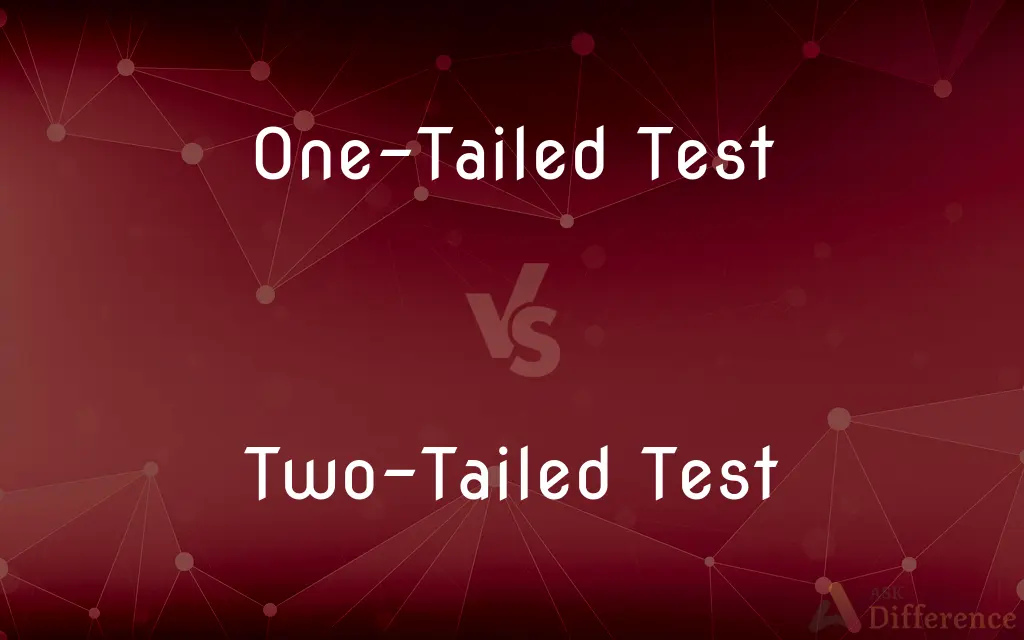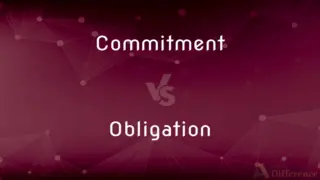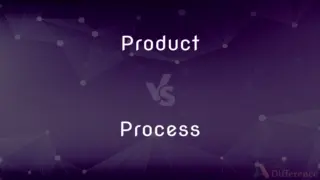One-Tailed Test vs. Two-Tailed Test — What's the Difference?
By Tayyaba Rehman — Published on January 13, 2024
A one-tailed test checks for an effect in one direction; a two-tailed test checks both directions.

Difference Between One-Tailed Test and Two-Tailed Test
Table of Contents
ADVERTISEMENT
Key Differences
The one-tailed test is a statistical test used to determine if there's a significant effect in a specific, predetermined direction. The two-tailed test, on the other hand, examines if there's a significant effect in either of the two possible directions without a predetermined notion.
In hypothesis testing, the one-tailed test is focused on either detecting a significant increase or decrease but not both. Conversely, the two-tailed test is versatile and checks for significant differences in both the positive and negative directions.
When researchers have a specific expectation or hypothesis about the direction of the effect, they might choose the one-tailed test. However, if they want to remain neutral and consider possibilities in both directions, the two-tailed test becomes the ideal choice.
The decision to use a one-tailed test often comes with a caution: it increases the risk of missing an effect in the untested direction. In comparison, the two-tailed test, being unbiased, is generally considered a safer and more common approach in many research scenarios.
Choosing between the one-tailed test and the two-tailed test isn't merely about statistical procedures but also about the nature of the research question. While the one-tailed test can provide more power to detect an effect in the expected direction, the two-tailed test ensures that unexpected outcomes in the opposite direction are also considered.
ADVERTISEMENT
Comparison Chart
Directionality
Tests in a predetermined direction
Tests in both possible directions
Hypothesis
Direction-specific (increase or decrease)
Neutral (either increase or decrease)
Research Application
When a specific direction is hypothesized
When no specific direction is hypothesized
Risk
Might miss an effect in the untested direction
Detects effects in both directions
Power
More power if the effect is in the expected direction
Spread out power in both directions
Compare with Definitions
One-Tailed Test
Increases the chance of type II error in the untested direction.
Some critics argue that our one-tailed test might've missed an opposite effect.
Two-Tailed Test
Ensures consideration of unexpected outcomes in both directions.
They opted for a two-tailed test to catch any unforeseen negative impacts of the intervention.
One-Tailed Test
Requires a predetermined expectation of the effect's direction.
Since we anticipated the intervention would reduce symptoms, a one-tailed test was used.
Two-Tailed Test
Examines for significant differences, either positive or negative.
Researchers used a two-tailed test to check any changes, either improvements or declines.
One-Tailed Test
Has more power in the tested direction.
To maximize power for detecting increased sales, the team used a one-tailed test.
Two-Tailed Test
A statistical procedure testing an effect in both possible directions.
Without a specific expectation about the drug's impact, a two-tailed test was appropriate.
One-Tailed Test
Focuses on either a significant increase or decrease.
Believing the new curriculum would improve grades, educators opted for a one-tailed test.
Two-Tailed Test
Commonly preferred due to its unbiased nature.
Given the uncertainty in outcome direction, most scholars advocate for a two-tailed test.
One-Tailed Test
A statistical procedure for testing an effect in a specific direction.
Given our hypothesis that the drug increases scores, we conducted a one-tailed test.
Two-Tailed Test
Neutral with respect to the direction of the effect.
To consider both benefits and drawbacks of the policy, a two-tailed test was conducted.
Common Curiosities
Is one-tailed test more powerful than two-tailed test?
A one-tailed test has more power if the effect is in the expected direction but risks missing effects in the untested direction.
Why might researchers avoid using a one-tailed test?
They might avoid it due to the risk of missing effects in the untested direction.
When is a one-tailed test typically used?
A one-tailed test is used when there's a specific hypothesis about the direction of the effect.
Which test is more common in general research scenarios?
The two-tailed test is more commonly used because of its unbiased approach.
How do the tests differ in terms of power?
One-tailed tests are more powerful in the tested direction, while two-tailed tests spread out power in both directions.
Can a one-tailed test detect negative effects if testing for positive ones?
No, a one-tailed test will only test in the predetermined direction.
Is there a risk associated with using a one-tailed test?
Yes, there's a risk of missing an effect in the untested direction.
When unsure about the direction of the effect, which test is advisable?
The two-tailed test is advisable when unsure about the direction of the effect.
What's the fundamental difference between a one-tailed test and a two-tailed test?
A one-tailed test checks in one predetermined direction, while a two-tailed test checks in both directions.
What's the primary advantage of using a two-tailed test?
A two-tailed test remains unbiased by checking for effects in both directions.
Is the choice between the tests only about statistical procedures?
No, it also depends on the nature of the research question.
How do the two tests differ in hypothesis framing?
One-tailed test has a direction-specific hypothesis, while a two-tailed test is directionally neutral.
In which test is the risk of a type II error greater in the untested direction?
In the one-tailed test, the risk of a type II error is greater in the untested direction.
Which test might be more suitable for exploratory research?
The two-tailed test, due to its ability to detect effects in both directions.
How does the two-tailed test ensure unexpected outcomes are considered?
It tests in both directions, allowing for the possibility of unexpected outcomes.
Share Your Discovery

Previous Comparison
Commitment vs. Obligation
Next Comparison
Product vs. ProcessAuthor Spotlight
Written by
Tayyaba RehmanTayyaba Rehman is a distinguished writer, currently serving as a primary contributor to askdifference.com. As a researcher in semantics and etymology, Tayyaba's passion for the complexity of languages and their distinctions has found a perfect home on the platform. Tayyaba delves into the intricacies of language, distinguishing between commonly confused words and phrases, thereby providing clarity for readers worldwide.













































